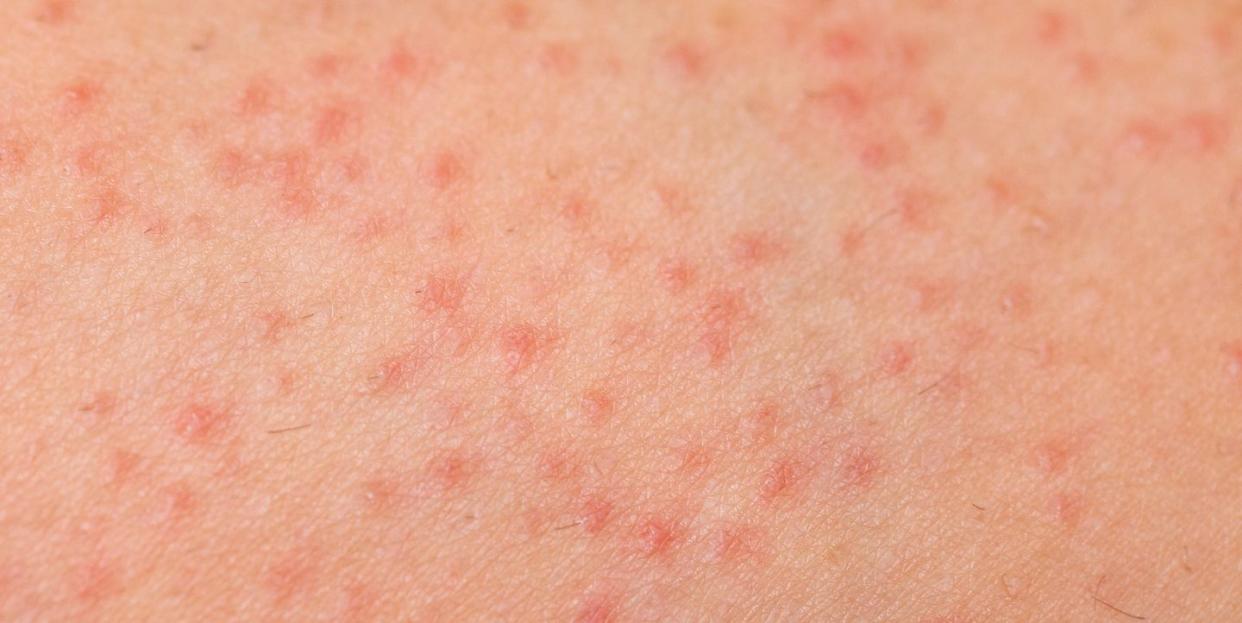How to Tell if You Have Fungal Acne—and the Best Way to Actually Get Rid of It

If you’re dealing with angry red bumps on your skin, your first thought (understandably) probably jumps to acne. But what if you’ve tried absolutely everything—a salicylic acid face wash, benzoyl peroxide spot treatment, or other common OTC acne products—and they’re just not fading away?
First, take a closer look at the spots. If you have inflamed, chicken skin-like bumps rather than your usual speckling of swollen pimples, you may actually be dealing with “fungal acne”—which technically isn’t like your normal acne at all.
Fungal acne is common during the warmer, humid months, making now the prime time to develop those little bumps across your hairline, jawline, butt, chest, and back—pretty much anywhere on your body. “I’ve been seeing it a lot in the office lately,” says Doris Day, M.D., a board-certified dermatologist at Advanced Dermatology and Aesthetics in New York City.
Here’s exactly how to differentiate fungal acne from your traditional breakout—and what you can do to get rid of it ASAP.
What is fungal acne, exactly?
First, a little acne 101: Your skin has tiny pores and, under normal circumstances, dead skin cells rise to the surface of the pore, where your body sheds them, according to the American Academy of Dermatology (AAD). But when your body starts to produce a lot of sebum (a.k.a. oil), those dead skin cells can stick together inside your pore and become clogged. Hello, pimple.
Most commonly, bacteria that lives on your skin, called P. acnes, gets trapped inside the clogged pore and causes inflammation in what’s known as bacterial acne, the AAD says. But sometimes the yeast that naturally lives on your skin is the problem and that causes fungal acne, Dr. Day says.
This is known as folliculitis, a common skin infection that develops in the hair follicles, per the AAD. It’s often called pityrosporum folliculitis or malassezia folliculitis, and “it’s inflammation of the hair follicle caused by an overgrowth of yeast on the skin,” says Joshua Zeichner, M.D., director of cosmetic and clinical research in dermatology at Mount Sinai Hospital in New York City.
What does fungal acne look like?

Fungal acne generally causes red bumps that are a little smaller than your standard acne bumps. “It’s more inflammatory papules and pustules rather than blackheads and whiteheads,” Dr. Day explains.
Each spot may also have a tiny red ring circling it (a sign of infection). “They are usually uniform and don’t come to a head like a regular pimple,” adds Gary Goldenberg, M.D., an assistant clinical professor of dermatology at the Icahn School of Medicine at Mount Sinai in New York City. Symptoms vary widely, so the spots can be sensitive to the touch or not painful at all, slightly swollen, or even itchy.
What causes fungal acne?
There are a few different things that could be behind your fungal acne. One is the type of medication you’ve been taking, specifically if you’ve been on a lot of antibiotics lately. “The antibiotics decrease the amount of normal bacterial flora, allowing yeast to overgrow and cause acne,” Dr. Goldenberg explains.
But it’s also common to develop fungal acne from sweating a lot. “Fungal acne tends to occur more frequently during hot, humid weather, when there is more sweat and oil on the skin,” Dr. Zeichner says. “That creates an environment that allows yeast to grow at higher-than-normal levels.”
But anything that stresses your hair follicles—wearing tight clothing, rubbing your skin often, chafing, shaving, or chilling in a not-so-clean hot tub—can lead to folliculitis.
How to get rid of fungal acne
Fungal acne is usually diagnosed through exclusion, meaning your doctor may suspect it after other traditional acne treatments, like products including salicylic acid or benzoyl peroxide, haven’t led to any improvement in your skin, Dr. Day says.
If your doctor determines that you have fungal acne, they’ll typically recommend a topical treatment. One popular recommendation? Use an anti-dandruff shampoo as a face and body wash. It seems a little odd, but “anti-dandruff shampoos are basically anti-yeast,” says Jules Lipoff, M.D., assistant professor of dermatology at the University of Pennsylvania’s Perelman School of Medicine. Lather up with the shampoo and let it sit for a minute before rinsing to make sure the product has time to do its job.
No luck with the shampoo? Your doctor may recommend a topical anti-fungal cream called nystatin, and if that doesn’t do the trick, they may ramp things up to an oral anti-fungal medication.
If you suspect your antibiotics are causing the issue, talk to your doctor about the course of your medication. Typically, the bumps will go away once you stop taking the medicine (although you still may need anti-fungal meds to clear things up), Dr. Goldenberg says.
Sweat and humidity could also be triggering your fungal acne, so Dr. Day recommends wearing looser clothes when you’re out and about to see if that helps reduce the issue. Be sure to change your clothes and wash your face and body well after you work out or get particularly sweaty.
Overall, if you have bumps on your body, you’re not sure what’s behind them, and nothing you try is making them go away, call your doctor. “This is not a diagnosis that most non-dermatologists are going to be able to make,” Dr. Lipoff says.
Support from readers like you helps us do our best work. Go here to subscribe to Prevention and get 12 FREE gifts. And sign up for our FREE newsletter here for daily health, nutrition, and fitness advice.
You Might Also Like

